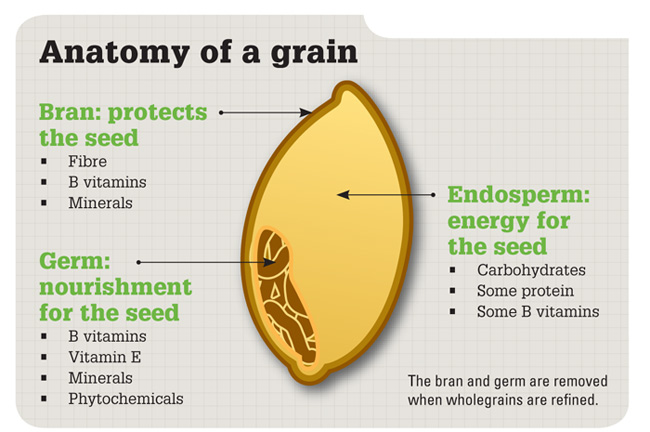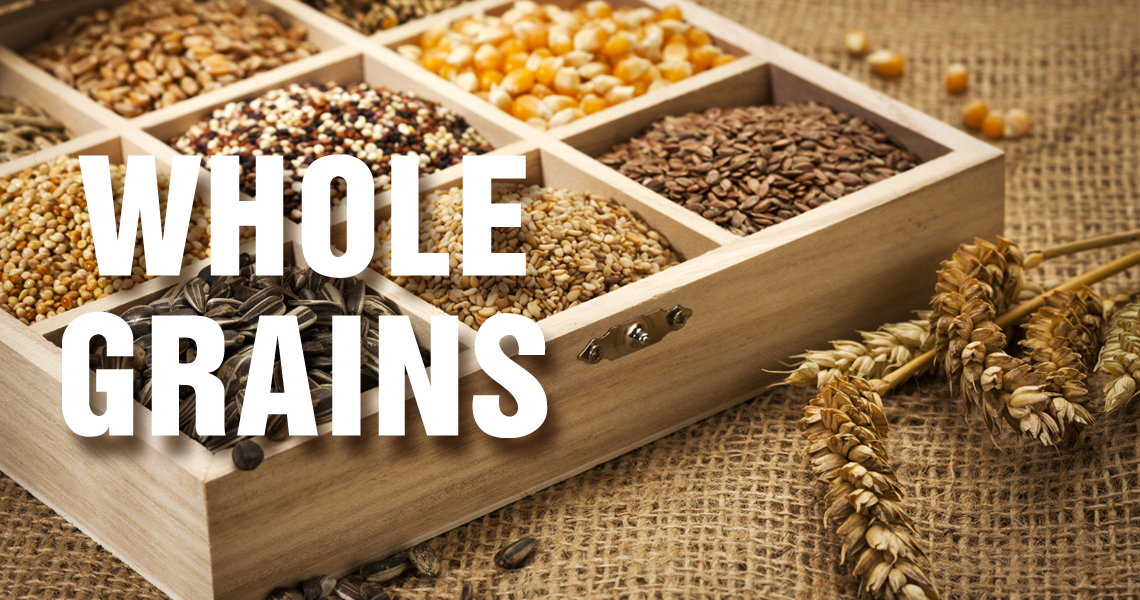It’s So Grainy….
What are whole grains?
Whole grains were defined in 2004 by the wholegrain council as follows “Whole grains or foods made from them contain all the essential parts and naturally-occurring nutrients of the entire grain seed in their original proportions. If the grain has been processed (e.g., cracked, crushed, rolled, extruded, and/or cooked), the food product should deliver the same rich balance of nutrients that are found in the original grain seed.”
If you are extremely confused by the above definition then in simple words, whole grains are the entire seed of a plant. This seed (which industry calls a “kernel”) is made up of three key edible parts – the bran, the germ, and the endosperm – protected by an inedible husk that protects the kernel from assaults by sunlight, pests, water, and disease.
The Anatomy of the whole Grain

The bran is the multi-layered outer skin of the edible kernel. It contains important antioxidants, B vitamins and fiber.
The germ is the embryo which has the potential to sprout into a new plant. It contains many B vitamins, some protein, minerals, and healthy fats.
The endosperm is the germ’s food supply, which provides essential energy to the young plant so it can send roots down for water and nutrients, and send sprouts up for sunlight’s photosynthesizing power. The endosperm is by far the largest portion of the kernel. It contains starchy carbohydrates, proteins and small amounts of vitamins and minerals.
Want to know more about Whole Grains?
Let’s watch this video of an expert Nutritionist Liz Vice who talks about the benefits of whole grains.
Health Benefits of Whole Grains –
The medical evidence is clear that whole grains reduce risks of heart disease, stroke, cancer, diabetesand obesity. Few foods can offer such diverse benefits.
People who eat whole grains regularly have a lower risk of obesity, as measured by their body massindex and waist-to- hip ratios. They also have lower cholesterol levels.
Because of the phytochemicals and antioxidants, people who eat three daily servings of whole grains have been shown to reduce their risk of heart disease by 25-36%, stroke by 37%, Type II diabetes by 21-27%, digestive system cancers by 21-43%, and hormone-related cancers by 10-40%.
Whole grain consumption recommendation
The most recent Dietary Guidelines for Americans, released in January 2011, recommend that all adults eat at least half their grains as whole grains – that’s at least 3 to 5 servings of whole grains. Even children need 2 to 3 servings or more. Recommendations in Canada’s Food Guide are almost exactly the same. (Not surprising, since the human body changes little from country to country!)
The health evidence has increasingly convinced governments and health organizations worldwide to recommend daily consumption of whole grains. Click here to see a listing of different countries’ recommendations for whole grain.
Yet consumption lags far behind these recommendations. For example, the average American eats less than one daily serving of whole grains, and some studies show that over 40% of Americans never eat whole grains at all.
Where do I start?
While three or more servings each day will optimize your health benefits, scientists and health experts agree that every bit of whole grain you eat contributes to your health. Even small amounts can start you on the road to better health. So look for ways to get a little here, a little there.
While it’s healthier to eat foods made totally with whole grains, you may want to change over gradually. To start, you can also get the whole grains you need from foods made with a mix of whole grains and refined grains.
This means you have lots of delicious choices that match your taste preferences. After a while, as your taste buds grow to love the fuller, nuttier taste of whole grains, some of your old favorites may seem surprisingly bland!
See ourYouTube page to find intersting receipes to incorporate in your daily meal.
| Grain | % of grain that is fiber | Fiber in 16g of this Grain |
| amaranth | 6.7% | 1.1 grams |
| barley | 17.3% | 2.8 grams |
| brown rice | 3.5% | 0.6 grams |
| buckwheat | 10.0% | 1.6 grams |
| bulgur wheat | 18.3% | 2.9 grams |
| corn | 7.3% | 1.2 grams |
| Kamut® khorasan wheat | 11.1% | 1.8 grams |
| millet | 8.5% | 1.4 grams |
| oats | 10.6% | 1.7 grams |
| quinoa | 7.0% | 1.1 grams |
| rye | 15.1% | 2.4 grams |
References
- What are whole grains and what are their health benefits
http://wholegrainscouncil.org/ - Video References
https://www.youtube.com/watch?v=j6OWmgqrcbY




Recent Comments